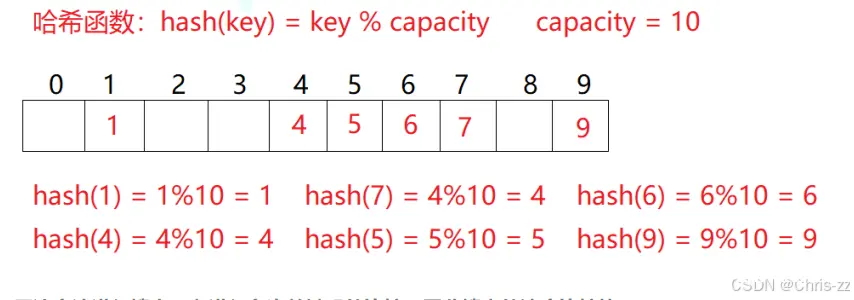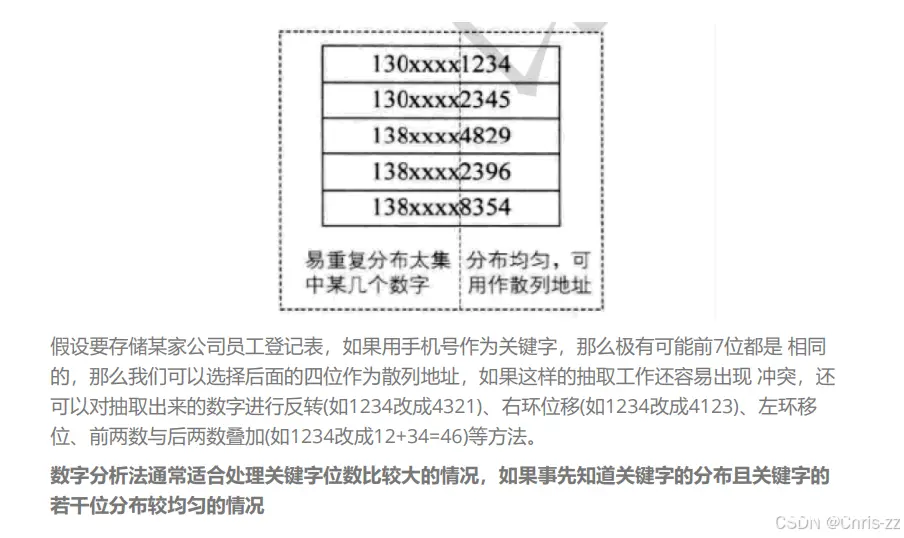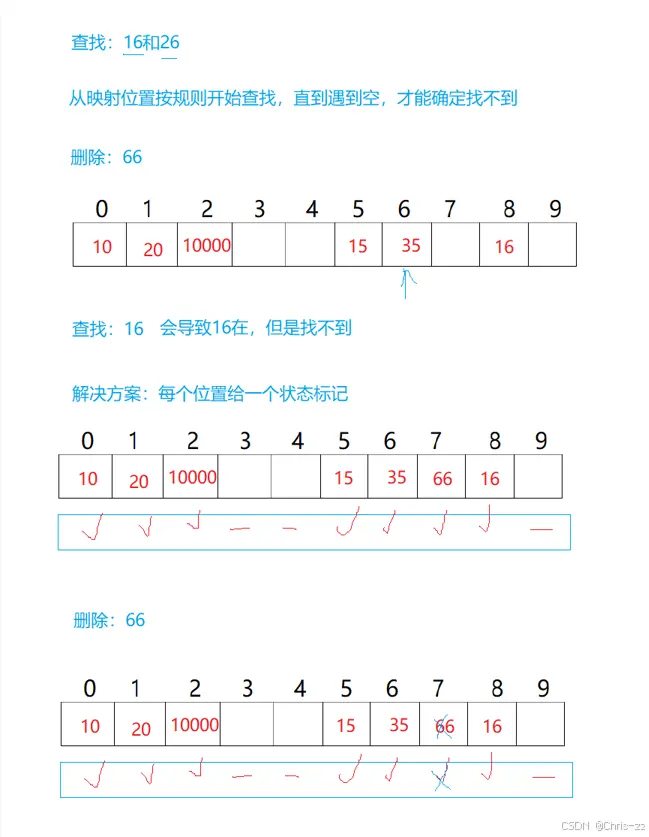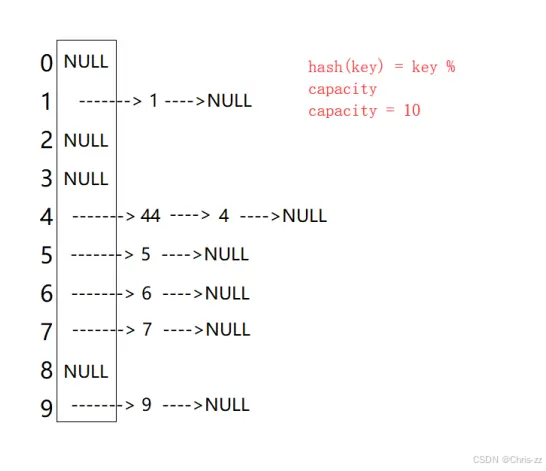C++:哈希表
Chris-zz 2024-09-14 16:35:01 阅读 65
✨✨✨学习的道路很枯燥,希望我们能并肩走下来!
文章目录
目录
文章目录
前言
一 哈希概念
二 哈希冲突
三 哈希函数
四 哈希冲突解决
4.1 闭散列
方法一:线性探测
方法二:二次探测
编辑4.2 开散列
4.3 开散列与闭散列比较
五 模拟实现
5.1 哈希表的改造
5.1.1. 模板参数列表的改造
5.1.2. 增加迭代器操作
5.2 unordered_map
5.3 unordered_set
总
前言
本篇详细介绍了进一步介绍C++中的哈希表,让使用者对哈希表有更加深刻的认知,而不是仅仅停留在表面,更好的模拟,为了更好的使用. 文章可能出现错误,如有请在评论区指正,让我们一起交流,共同进步!
一 哈希概念
顺序结构以及平衡树中,元素关键码与其存储位置之间没有对应的关系,因此在查找一个元素 时,必须要经过关键码的多次比较。顺序查找时间复杂度为O(N),平衡树中为树的高度,即 O(log_2 N),搜索的效率取决于搜索过程中元素的比较次数。
理想的搜索方法:可以不经过任何比较,一次直接从表中得到要搜索的元素。 如果构造一种存储结构,通过某种函数(hashFunc)使元素的存储位置与它的关键码之间能够建立 一一映射的关系,那么在查找时通过该函数可以很快找到该元素。
当向该结构中:
◎ 插入元素
根据待插入元素的关键码,以此函数计算出该元素的存储位置并按此位置进行存放
◎ 搜索元素
对元素的关键码进行同样的计算,把求得的函数值当做元素的存储位置,在结构中按此位置取元素比较,若关键码相等,则搜索成功
该方式即为哈希(散列)方法,哈希方法中使用的转换函数称为哈希(散列)函数,构造出来的结构称为哈希表(Hash Table)(或者称散列表)

用该方法进行搜索不必进行多次关键码的比较,因此搜索的速度比较快
二 哈希冲突
对于两个数据元素的关键字即:不同关键字通过相同哈希函数计算出相同的哈希地址,该种现象称为哈希冲突或哈希碰撞。
把具有不同关键码而具有相同哈希地址的数据元素称为“同义词”
发生哈希冲突该如何处理呢?
三 哈希函数
引起哈希冲突的一个原因可能是:哈希函数设计不够合理。
哈希函数设计原则:
● 哈希函数的定义域必须包括需要存储的全部关键码,而如果散列表允许有m个地址时,其值域必须在0到m-1之间
● 哈希函数计算出来的地址能均匀分布在整个空间中
● 哈希函数应该比较简单
常见哈希函数 :
1. 直接定址法--(常用)
取关键字的某个线性函数为散列地址:Hash(Key)= A*Key + B
优点:简单、均匀
缺点:需要事先知道关键字的分布情况,只适合范围相对集中的数据
使用场景:适合查找比较小且连续的情况
387. 字符串中的第一个唯一字符 - 力扣(LeetCode)
<code>class Solution {
public:
int firstUniqChar(string s) {
int count[26]={0};
for(auto n : s)
{
count[n-'a']++;
}
for(int i = 0;i<s.size();i++)
{
if(count[s[i]-'a']==1)
return i;
}
return -1;
}
};
2. 除留余数法--(常用)
设散列表中允许的地址数为m,取一个不大于m,但最接近或者等于m的质数p作为除数, 按照哈希函数:Hash(key) = key% p(p<=m),将关键码转换成哈希地址
3. 平方取中法--(了解)
假设关键字为1234,对它平方就是1522756,抽取中间的3位227作为哈希地址; 再比如关键字为4321,对它平方就是18671041,抽取中间的3位671(或710)作为哈希地址
平方取中法比较适合:不知道关键字的分布,而位数又不是很大的情况
4. 折叠法--(了解)
折叠法是将关键字从左到右分割成位数相等的几部分(最后一部分位数可以短些),然后将这 几部分叠加求和,并按散列表表长,取后几位作为散列地址。
折叠法适合事先不需要知道关键字的分布,适合关键字位数比较多的情况
5. 随机数法--(了解)
选择一个随机函数,取关键字的随机函数值为它的哈希地址,即H(key) = random(key),其中 random为随机数函数。
通常应用于关键字长度不等时采用此法
6. 数学分析法--(了解)
设有n个d位数,每一位可能有r种不同的符号,这r种不同的符号在各位上出现的频率不一定 相同,可能在某些位上分布比较均匀,每种符号出现的机会均等,在某些位上分布不均匀只 有某几种符号经常出现。可根据散列表的大小,选择其中各种符号分布均匀的若干位作为散列地址。例如:

注意:哈希函数设计的越精妙,产生哈希冲突的可能性就越低,但是无法避免哈希冲突
四 哈希冲突解决
解决哈希冲突两种常见的方法是:闭散列和开散列
4.1 闭散列
闭散列:也叫开放定址法,当发生哈希冲突时,如果哈希表未被装满,说明在哈希表中必然还有 空位置,那么可以把key存放到冲突位置中的“下一个” 空位置中去。那如何寻找下一个空位置呢?
方法一:线性探测
线性探测:从发生冲突的位置开始,依次向后探测,直到寻找到下一个空位置为止。
◎ 插入

◎ 删除
采用闭散列处理哈希冲突时,不能随便物理删除哈希表中已有的元素,若直接删除元素 会影响其他元素的搜索。比如删除元素4,如果直接删除掉,44查找起来可能会受影响。因此线性探测采用标记的伪删除法来删除一个元素。
<code>// 哈希表每个空间给个标记
// EMPTY此位置空, EXIST此位置已经有元素, DELETE元素已经删除
enum State{EMPTY, EXIST, DELETE};

哈希表什么情况下进行扩容?如何扩容?


线性探测的实现
<code>#pragma once
#include<iostream>
#include<vector>
using namespace std;
namespace Close_Hash
{
template<class K>
struct HashFunc
{
size_t operator()(const K& key)
{
return (size_t)key;
}
};
template<>
struct HashFunc<string>
{
size_t operator()(const string& key)
{
size_t hash = 0;
for (auto e : key)
{
hash *= 31;
hash += e;
}
return hash;
}
};
enum State
{
EXIST,
EMPTY,
DELETE
};
template<class K, class V>
struct HashData
{
pair<K, V> _kv;
State _state = EMPTY;
};
template<class K, class V, class Hash = HashFunc<K>>
class HashTable
{
public:
HashTable()
{
_tables.resize(10);
}
bool Insert(const pair<K, V>& kv)
{
if (Find(kv.first))
return false;
if (_n * 10 / _tables.size() >= 7)
{
HashTable<K, V, Hash> newHT;
newHT._tables.resize(2 * _tables.size());
for (int i = 0; i < _tables.size(); i++)
{
if (_tables[i]._state == EXIST)
{
newHT.Insert(_tables[i]._kv);
}
}
_tables.swap(newHT._tables);
}
Hash hs;
size_t hashi = hs(kv.first) % _tables.size();
while (_tables[hashi]._state == EXIST)
{
hashi++;
hashi %= _tables.size();
}
_tables[hashi]._state = EXIST;
_tables[hashi]._kv = kv;
_n++;
}
HashData<K, V>* Find(const K& key)
{
Hash hs;
size_t hashi = hs(key) % _tables.size();
while (_tables[hashi]._state != EMPTY)
{
if (_tables[hashi]._state == EXIST&& _tables[hashi]._kv.first == key)
{
return &_tables[hashi];
}
++hashi;
hashi %= _tables.size();
}
return nullptr;
}
bool Erase(const K& key)
{
HashData<K, V>* ret = Find(key);
if (ret)
{
ret->_state = DELETE;
return true;
}
else
{
return false;
}
_n--;
}
private:
vector<HashData<K, V>> _tables;
size_t _n = 0; // 表中存储数据个数
};
void TestHT1()
{
HashTable<int, int> ht;
int a[] = { 11,21,4,14,24,15,9 };
for (auto e : a)
{
ht.Insert({ e,e });
}
ht.Insert({ 19,19 });
ht.Insert({ 19,190 });
ht.Insert({ 19,1900 });
ht.Insert({ 39,1900 });
cout << ht.Find(24) << endl;
ht.Erase(4);
cout << ht.Find(24) << endl;
cout << ht.Find(4) << endl;
}
}
线性探测优点:实现非常简单,
线性探测缺点:一旦发生哈希冲突,所有的冲突连在一起,容易产生数据“堆积”,即:不同 关键码占据了可利用的空位置,使得寻找某关键码的位置需要许多次比较,导致搜索效率降低。如何缓解呢?
方法二:二次探测
线性探测的缺陷是产生冲突的数据堆积在一块,这与其找下一个空位置有关系,因为找空位 置的方式就是挨着往后逐个去找,因此二次探测为了避免该问题,
找下一个空位置的方法为:二次探测相对线性探测的区别在于,在查找空位置时跳跃式的前后交替查找,每次的步长都是前一次的二次方

4.2 开散列
开散列法又叫哈希桶/拉链法,首先对关键码集合用散列函数计算散列地址,具有相同地 址的关键码归于同一子集合,每一个子集合称为一个桶,各个桶中的元素通过一个单链表链 接起来,各链表的头结点存储在哈希表中。
在哈希桶中,其每一个位置都是一个链表,原本会产生哈希冲突的、具有相同哈希地址的元素归并成一个集合,用链表链接起来,称为一个桶,并将各个链表的头节点存储在哈希表中

从上图可以看出,开散列中每个桶中放的都是发生哈希冲突的元素。
所以用开散列法插入元素和删除元素,按照链表的方式进行操作即可。需要注意的是,因为我们采用的是单链表,不好找尾,所以插入元素时应该头插

桶的个数是一定的,随着元素的不断插入,每个桶中元素的个数不断增多,极端情况下,可能会导致一个桶中链表节点非常多,会影响的哈希表的性能,因此在一定条件下需要对哈希 表进行增容,那该条件怎么确认呢?开散列最好的情况是:每个哈希桶中刚好挂一个节点, 再继续插入元素时,每一次都会发生哈希冲突,因此,在元素个数刚好等于桶的个数时,可以给哈希表增容。
哈希桶的负载因子可以开到1,也就是平均每个位置都有一个元素。当达到条件时,首先创建一个新表,重新将每个节点映射到新表中,然后销毁旧表。
开散列实现
<code>namespace hash_bucket // 哈希桶:数组加单链表
{
template<class K, class V>
struct HashNode
{
HashNode(const pair<K, V>& kv)
:_kv(kv)
,_next(nullptr)
{}
pair<K, V> _kv;
HashNode* _next;
};
template<class K>
struct HashMapping
{
size_t operator()(const K& key)
{
return (size_t)key;
}
};
template<>
struct HashMapping<string>
{
size_t operator()(const string& key)
{
// BKDR字符串哈希
size_t ret = 0;
for (auto i : key)
{
ret *= 31;
ret += i;
}
return ret;
}
};
template<class K, class V, class Hash = HashMapping<K>>
class HashTable
{
typedef HashNode<K, V> Node;
public:
HashTable()
{
_tables.resize(10);
}
~HashTable() // vector可以自己析构,但哈希桶需要我们手动析构
{
for (size_t i = 0; i < _tables.size(); i++)
{
Node* cur = _tables[i];
while (cur)
{
Node* next = cur->_next;
delete cur;
cur = next;
}
_tables[i] = nullptr;
}
}
bool Insert(const pair<K, V> kv)
{
if (Find(kv.first)) return false;
Hash hf;
if (_n == _tables.size()) // 负载因子为1时扩容
{
// 为了避免析构和重新创建节点的消耗,直接把旧表中的节点重新映射至新表
vector<Node*> new_tables;
new_tables.resize(_tables.size() * 2);
// 遍历旧表
for (size_t i = 0; i < _tables.size(); i++)
{
Node* cur = _tables[i];
while (cur)
{
Node* next = cur->_next; // 头插会改变节点的指向,所以需要保存next
// 计算新的映射位置
size_t new_hashi = hf(cur->_kv.first) % new_tables.size();
cur->_next = new_tables[new_hashi];
new_tables[new_hashi] = cur;
cur = next;
}
_tables[i] = nullptr;
}
_tables.swap(new_tables);
}
size_t hashi = hf(kv.first) % _tables.size();
Node* newnode = new Node(kv);
// 哈希桶头插
newnode->_next = _tables[hashi];
_tables[hashi] = newnode;
_n++;
return true;
}
bool Erase(const K& key)
{
Hash hf;
size_t hashi = hf(key) % _tables.size();
Node* prev = nullptr; // 单链表无法找头,需要提前保存
Node* cur = _tables[hashi];
while (cur)
{
if (cur->_kv.first == key)
{
if (prev == nullptr) // 待删除节点在头部
_tables[hashi] = cur->_next;
else
prev->_next = cur->_next;
delete cur;
return true;
}
prev = cur;
cur = cur->_next;
}
return false;
}
Node* Find(const K& key)
{
Hash hf;
size_t hashi = hf(key) % _tables.size();
Node* cur = _tables[hashi];
while (cur)
{
if (cur->_kv.first == key)
return cur;
cur = cur->_next;
}
return nullptr;
}
void Print()
{
for (int i = 0; i < _tables.size(); i++)
{
cout << i << " : ";
Node* cur = _tables[i];
while (cur)
{
cout << "[" << cur->_kv.first << "," << cur->_kv.second << "]" << "->";
cur = cur->_next;
}
cout << endl;
}
cout << endl;
}
size_t size()
{
return _n;
}
private:
vector<Node*> _tables;
size_t _n = 0;
};
}
4.3 开散列与闭散列比较
应用哈希桶法处理溢出,需要增设链接指针,似乎增加了存储开销。事实上: 由于开地址法必须保持大量的空闲空间以确保搜索效率,如二次探查法要求装载因子a <= 0.7,而表项所占空间又比指针大的多,所以使用链地址法反而比开地址法节省存储空间。
五 模拟实现
5.1 哈希表的改造
5.1.1. 模板参数列表的改造
// K:关键码类型
// V: 不同容器V的类型不同,如果是unordered_map,V代表一个键值对,如果是
unordered_set,V 为 K
// KeyOfValue: 因为V的类型不同,通过value取key的方式就不同,详细见
unordered_map/set的实现
// HF: 哈希函数仿函数对象类型,哈希函数使用除留余数法,需要将Key转换为整形数字才能
取模
template<class K, class V, class KeyOfValue, class HF = DefHashF<T> >
class HashBucket;
5.1.2. 增加迭代器操作
#pragma once
#include<iostream>
#include<vector>
using namespace std;
template<class K>
struct HashFunc
{
size_t operator()(const K& key)
{
return (size_t)key;
}
};
// 特化
template<>
struct HashFunc<string>
{
size_t operator()(const string& key)
{
size_t hash = 0;
for (auto e : key)
{
hash *= 31;
hash += e;
}
return hash;
}
};
namespace hash_bucket
{
template<class T>
struct HashNode
{
T _data;
HashNode<K, V>* _next;
HashNode(const T& data)
:_data(data)
, _next(nullptr)
{}
};
// 前置声明
template<class K, class T, class KeyOfT, class Hash>
class HashTable;
template<class K, class T, class Ptr, class Ref, class KeyOfT, class Hash>
struct HTIterator
{
typedef HashNode<T> Node;
typedef HTIterator<K, T, Ptr, Ref, KeyOfT, Hash> Self;
Node* _node;
const HashTable<K, T, KeyOfT, Hash>* _pht;
HTIterator(Node* node, const HashTable<K, T, KeyOfT, Hash>* pht)
:_node(node)
, _pht(pht)
{}
Ref operator*()
{
return _node->_data;
}
Ptr operator->()
{
return &_node->_data;
}
bool operator!=(const Self& s)
{
return _node != s._node;
}
Self& operator++()
{
if (_node->_next)
{
// 当前桶还有节点
_node = _node->_next;
}
else
{
// 当前桶走完了,找下一个不为空的桶
KeyOfT kot;
Hash hs;
size_t hashi = hs(kot(_node->_data)) % _pht->_tables.size();
++hashi;
while (hashi < _pht->_tables.size())
{
if (_pht->_tables[hashi])
{
break;
}
++hashi;
}
if (hashi == _pht->_tables.size())
{
_node = nullptr; // end()
}
else
{
_node = _pht->_tables[hashi];
}
}
return *this;
}
};
template<class K, class T, class KeyOfT, class Hash = HashFunc<K>>
class HashTable
{
// 友元声明
template<class K, class T, class Ptr, class Ref, class KeyOfT, class Hash>
friend struct HTIterator;
typedef HashNode<T> Node;
public:
typedef HTIterator<K, T, T*, T&, KeyOfT, Hash> Iterator;
typedef HTIterator<K, T, const T*, const T&, KeyOfT, Hash> ConstIterator;
Iterator Begin()
{
if (_n == 0)
return End();
for (size_t i = 0; i < _tables.size(); i++)
{
Node* cur = _tables[i];
if (cur)
{
return Iterator(cur, this);
}
}
return End();
}
Iterator End()
{
return Iterator(nullptr, this);
}
ConstIterator Begin() const
{
if (_n == 0)
return End();
for (size_t i = 0; i < _tables.size(); i++)
{
Node* cur = _tables[i];
if (cur)
{
return ConstIterator(cur, this);
}
}
return End();
}
ConstIterator End() const
{
return ConstIterator(nullptr, this);
}
HashTable()
{
_tables.resize(10, nullptr);
}
~HashTable()
{
// 依次把每个桶释放
for (size_t i = 0; i < _tables.size(); i++)
{
Node* cur = _tables[i];
while (cur)
{
Node* next = cur->_next;
delete cur;
cur = next;
}
_tables[i] = nullptr;
}
}
pair<Iterator, bool> Insert(const T& data)
{
KeyOfT kot;
Iterator it = Find(kot(data));
if (it != End())
return make_pair(it, false);
Hash hs;
size_t hashi = hs(kot(data)) % _tables.size();
// 负载因子==1扩容
if (_n == _tables.size())
{
vector<Node*> newtables(_tables.size() * 2, nullptr);
for (size_t i = 0; i < _tables.size(); i++)
{
Node* cur = _tables[i];
while (cur)
{
Node* next = cur->_next;
// 旧表中节点,挪动新表重新映射的位置
size_t hashi = hs(cur->_kv.first) % newtables.size();
// 头插到新表
cur->_next = newtables[hashi];
newtables[hashi] = cur;
cur = next;
}
_tables[i] = nullptr;
}
_tables.swap(newtables);
}
// 头插
Node* newnode = new Node(data);
newnode->_next = _tables[hashi];
_tables[hashi] = newnode;
++_n;
return make_pair(Iterator(newnode, this), true);
}
Iterator Find(const K& key)
{
Hash hs;
KeyOfT kot;
size_t hashi = hs(key) % _tables.size();
Node* cur = _tables[hashi];
while (cur)
{
if (kot(cur->_data) == key)
{
return Iterator(cur, this);
}
cur = cur->_next;
}
return End();
}
bool Erase(const K& key)
{
Hash hs;
KeyOfT kot;
size_t hashi = hs(key) % _tables.size();
Node* prev = nullptr;
Node* cur = _tables[hashi];
while (cur)
{
if ((cur->_data) == key)
{
if (prev == nullptr)
{
_tables[hashi] = cur->_next;
}
else
{
prev->_next = cur->_next;
}
delete cur;
--_n;
return true;
}
prev = cur;
cur = cur->_next;
}
return false;
}
private:
vector<Node*> _tables; // 指针数组
size_t _n = 0;// 表中存储数据个数
};
}
5.2 unordered_map
#pragma once
#include "HashTable2.h"
namespace ch
{
template<class K, class V, class Hash = HashFunc<K>>
class unordered_map
{
struct MapKeyOfT
{
const K& operator()(const pair<K, V>& kv)
{
return kv.first;
}
};
public:
typedef typename hash_bucket::HashTable<K, pair<const K, V>, MapKeyOfT, Hash>::Iterator iterator;
typedef typename hash_bucket::HashTable<K, pair<const K, V>, MapKeyOfT, Hash>::ConstIterator const_iterator;
iterator begin()
{
return _ht.Begin();
}
iterator end()
{
return _ht.End();
}
const_iterator begin() const
{
return _ht.Begin();
}
const_iterator end() const
{
return _ht.End();
}
pair<iterator, bool> insert(const pair<K, V>& kv)
{
return _ht.Insert(kv);
}
V& operator[](const K& key)
{
pair<iterator, bool> ret = _ht.Insert(make_pair(key, V()));
return ret.first->second;
}
iterator Find(const K& key)
{
return _ht.Find(key);
}
bool Erase(const K& key)
{
return _ht.Erase(key);
}
private:
hash_bucket::HashTable<K, pair<const K, V>, MapKeyOfT, Hash> _ht;
};
}
5.3 unordered_set
#pragma once
#include "HashTable2.h"
namespace ch
{
template<class K, class Hash = HashFunc<K>>
class unordered_set
{
struct SetKeyOfT
{
const K& operator()(const K& key)
{
return key;
}
};
public:
typedef typename hash_bucket::HashTable<K, const K, SetKeyOfT, Hash>::Iterator iterator;
typedef typename hash_bucket::HashTable<K, const K, SetKeyOfT, Hash>::ConstIterator const_iterator;
iterator begin()
{
return _ht.Begin();
}
iterator end()
{
return _ht.End();
}
const_iterator begin() const
{
return _ht.Begin();
}
const_iterator end() const
{
return _ht.End();
}
pair<iterator, bool> insert(const K& key)
{
return _ht.Insert(key);
}
iterator Find(const K& key)
{
return _ht.Find(key);
}
bool Erase(const K& key)
{
return _ht.Erase(key);
}
private:
hash_bucket::HashTable<K, const K, SetKeyOfT, Hash> _ht;
};
}
总结
✨✨✨各位读友,本篇分享到内容是否更好的让你理解哈希,如果对你有帮助给个👍赞鼓励一下吧!!
🎉🎉🎉世上没有绝望的处境,只有对处境绝望的人。
感谢每一位一起走到这的伙伴,我们可以一起交流进步!!!一起加油吧!!
声明
本文内容仅代表作者观点,或转载于其他网站,本站不以此文作为商业用途
如有涉及侵权,请联系本站进行删除
转载本站原创文章,请注明来源及作者。
